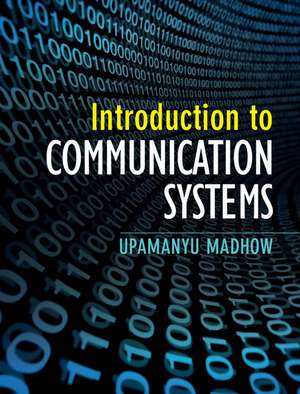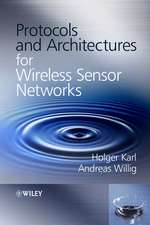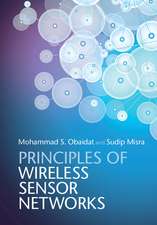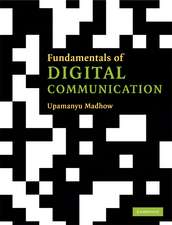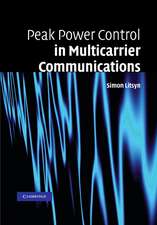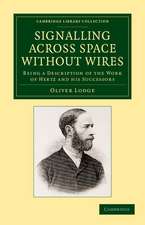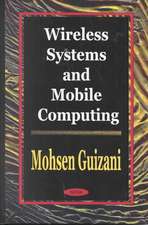Introduction to Communication Systems
Autor Upamanyu Madhowen Limba Engleză Hardback – 23 noi 2014
Preț: 524.91 lei
Preț vechi: 589.79 lei
-11% Nou
Puncte Express: 787
Preț estimativ în valută:
100.44€ • 104.88$ • 82.94£
100.44€ • 104.88$ • 82.94£
Carte tipărită la comandă
Livrare economică 15-29 aprilie
Preluare comenzi: 021 569.72.76
Specificații
ISBN-13: 9781107022775
ISBN-10: 1107022770
Pagini: 512
Ilustrații: 430 b/w illus. 200 exercises
Dimensiuni: 195 x 253 x 29 mm
Greutate: 1.36 kg
Ediția:New.
Editura: Cambridge University Press
Colecția Cambridge University Press
Locul publicării:New York, United States
ISBN-10: 1107022770
Pagini: 512
Ilustrații: 430 b/w illus. 200 exercises
Dimensiuni: 195 x 253 x 29 mm
Greutate: 1.36 kg
Ediția:New.
Editura: Cambridge University Press
Colecția Cambridge University Press
Locul publicării:New York, United States
Cuprins
Part I. Introduction: 1.1 Analog or digital?; 1.2 A technology perspective; 1.3 The scope of this textbook; 1.4 Why study communication systems?; 1.5 Concept summary; 1.6 Notes; Part II. Signals and Systems: 2.1 Complex numbers; 2.2 Signals; 2.3 Linear time-invariant systems; 2.4 Fourier series; 2.5 The Fourier transform; 2.6 Energy spectral density and bandwidth; 2.7 Baseband and passband signals; 2.8 The structure of a passband signal; 2.9 Wireless-channel modeling in complex baseband; 2.10 Concept summary; 2.11 Notes; 2.12 Problems; Software labs; Part III. Analog Communication Techniques: 3.1 Terminology and notation; 3.2 Amplitude modulation; 3.3 Angle modulation; 3.3.1 Limiter-discriminator demodulation; 3.4 The superheterodyne receiver; 3.5 The phase-locked loop; 3.6 Some analog communication systems; 3.7 Concept summary; 3.8 Notes; 3.9 Problems; Software labs; Part IV. Digital Modulation: 4.1 Signal constellations; 4.2 Bandwidth occupancy; 4.3 Design for bandlimited channels; 4.4 Orthogonal and biorthogonal modulation; 4.5 Proofs of the Nyquist theorems; 4.6 Concept summary; 4.7 Notes; 4.8 Problems; Software lab; Appendices; Part V. Probability and Random Processes: 5.1 Probability basics; 5.2 Random variables; 5.3 Multiple random variables, or random vectors; 5.4 Functions of random variables; 5.5 Expectation; 5.6 Gaussian random variables; 5.7 Random processes; 5.8 Noise modeling; 5.9 Linear operations on random processes; 5.10 Concept summary; 5.11 Notes; 5.12 Problems; Appendices; Part VI. Optimal Demodulation: 6.1 Hypothesis testing; 6.2 Signal-space concepts; 6.3 Performance analysis of ML reception; 6.4 Bit error probability; 6.5 Link-budget analysis; 6.6 Concept summary; 6.7 Notes; 6.8 Problems; Software labs; Part VII. Channel Coding: 7.1 Motivation; 7.2 Model for channel coding; 7.3 Shannon's promise; 7.4 Introducing linear codes; 7.5 Soft decisions and belief propagation; 7.6 Concept summary; 7.7 Notes; 7.8 Problems; Part VIII. Dispersive Channels and MIMO: 8.1 The single-carrier system model; 8.2 Linear equalization; 8.3 Orthogonal frequency-division multiplexing; 8.4 MIMO; 8.5 Concept summary; 8.6 Notes; 8.7 Problems; Software labs.
Recenzii
'Madhow does it again: Introduction to Communication Systems is an accessible yet rigorous new text that does for undergraduates what his [Fundamentals of] Digital Communication book did for graduate students. It provides a superior treatment of not only the fundamentals of analog and digital communication, but also the theoretical underpinnings needed to understand them, including frequency domain analysis and probability. The book is unusual in that it also includes newer topics of pressing current relevance like multiple antenna communication and OFDM. I strongly recommend this book for faculty teaching senior level courses on communication systems.' Jeffrey G. Andrews, University of Texas, Austin
'This is an excellent undergraduate text on analog and digital communications. It covers everything from classic analog techniques to recent wireless systems. Students will enjoy the inclusion of advanced topics such as channel coding and MIMO.' David Love, Purdue University, Indiana
'Introduction to Communication Systems by Madhow is truly unique in the vast landscape of introductory books on communication systems. From the basics of signal processing, probability, and communications, to the advanced topics of coding, multipath mitigation, and multiple antenna systems, the book deftly interweaves abstract theory, design principles, and applications in a highly effective and insightful manner. This masterfully written book will play a key role in teaching and inspiring the next generation of communication system engineers.' Andrea Goldsmith, Stanford University, California
'This is the textbook on communications I have wanted for a while. Crisply written, it forms the basis for an ideal two-semester sequence. It nicely balances rigor, concepts and practice.' Saoura Dasgupta, University of Iowa
'This is a unique introduction to the basic principles of communication system design, with a remarkable combination of rigour and accessibility. The MATLAB exercises are expertly weaved together with theoretical principles making it an excellent textbook for training undergraduate communication systems engineers.' Suhas Diggavi, University of California, Los Angeles
'This is a valuable addition to the current set of textbooks on communication systems. It is comprehensive, and offers a modern perspective shaped by the author's research that has pushed the state of the art. The software labs enhance the practicality of the text and serve to illustrate more advanced material in an accessible way.' Michael Honig, Northwestern University, Illinois
'… an interesting introduction to communication systems that offers the readers an overview of problems related to signals and systems. It covers theoretical analysis of communications systems together with more practical approaches … It gives an appropriate background for those who have a limited knowledge in this area … [The book] offer[s] to readers a good introduction to linearly modulated signals, and different signalling constellations used for baseband and passband channels …' Jozef Wozniak, Zentralblatt MATH
'This is an excellent undergraduate text on analog and digital communications. It covers everything from classic analog techniques to recent wireless systems. Students will enjoy the inclusion of advanced topics such as channel coding and MIMO.' David Love, Purdue University, Indiana
'Introduction to Communication Systems by Madhow is truly unique in the vast landscape of introductory books on communication systems. From the basics of signal processing, probability, and communications, to the advanced topics of coding, multipath mitigation, and multiple antenna systems, the book deftly interweaves abstract theory, design principles, and applications in a highly effective and insightful manner. This masterfully written book will play a key role in teaching and inspiring the next generation of communication system engineers.' Andrea Goldsmith, Stanford University, California
'This is the textbook on communications I have wanted for a while. Crisply written, it forms the basis for an ideal two-semester sequence. It nicely balances rigor, concepts and practice.' Saoura Dasgupta, University of Iowa
'This is a unique introduction to the basic principles of communication system design, with a remarkable combination of rigour and accessibility. The MATLAB exercises are expertly weaved together with theoretical principles making it an excellent textbook for training undergraduate communication systems engineers.' Suhas Diggavi, University of California, Los Angeles
'This is a valuable addition to the current set of textbooks on communication systems. It is comprehensive, and offers a modern perspective shaped by the author's research that has pushed the state of the art. The software labs enhance the practicality of the text and serve to illustrate more advanced material in an accessible way.' Michael Honig, Northwestern University, Illinois
'… an interesting introduction to communication systems that offers the readers an overview of problems related to signals and systems. It covers theoretical analysis of communications systems together with more practical approaches … It gives an appropriate background for those who have a limited knowledge in this area … [The book] offer[s] to readers a good introduction to linearly modulated signals, and different signalling constellations used for baseband and passband channels …' Jozef Wozniak, Zentralblatt MATH
Descriere
An accessible undergraduate textbook introducing key fundamental principles behind modern communication systems, supported by exercises, software problems and lab exercises.
